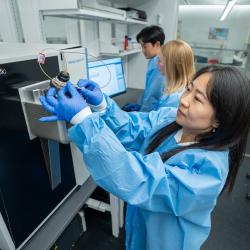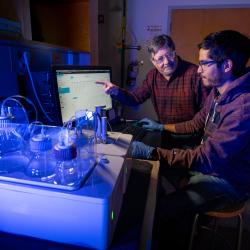Chemistry Getting a New Wing to Advance Research Frontiers and Train Students
Walking through the painted cinderblock corridors of the University of Maryland’s 1960s-era chemistry building, there is very little hint of the groundbreaking, collaborative research taking place. Faculty members and students in the Department of Chemistry and Biochemistry are making major discoveries that garner international attention, but the decades-old chemistry building is a poor reflection of their stature and renown. What’s more, the obsolete design and lack of utilities severely limit the research activities faculty members and students can accomplish on site.
But that’s about to change. Wing one of the chemistry building is coming down and will be replaced by a state-of-the-art facility. This new 105,000 square-foot wing will expand the scope of physical and analytical chemistry research at UMD, support new approaches in materials synthesis and characterization, and create the collaborative environment necessary for harnessing these discoveries into transformative applications.
Both the state of Maryland and the university recognize the value that this new facility will bring. They committed $105 million and $10 million, respectively, to construction and recently announced Whiting-Turner Contracting Company as the design/build firm for the job. UMD Senior Vice President and Provost Mary Ann Rankin set an accelerated schedule for the project, with plans to tear down the current wing in winter 2020 and move faculty members into their new home by the end of 2023.
“We’re very excited about the opportunities this new building offers,” said Janice Reutt-Robey, chair of the department. “The facility is being designed to enable things we haven’t been able to do before. For example, air handling systems engineered specifically for modern lab work will allow us to achieve very precise temperature and humidity control for the first time in the chemistry complex.”
The new facility will aid in existing research, but also serve as a powerful recruitment tool. The lack of precise environmental control has hindered recruitment of faculty members in both synthesis research (the creation of new materials and chemicals) and measurement science, where electrochemical and optical measurements are very sensitive to humidity.
The wing will include research space for 20 faculty members and their students as well as light-filled offices and collaboration areas. Importantly, this space will allow the size of the faculty to grow by nearly a dozen. The new facility will bolster key research into areas such as nanomaterials, energy and environmental chemistry, soft materials and biologics. According to Dr. Reutt-Robey, one of the overarching principles guiding the development of the new building is the promotion of green, or sustainable, chemistry.
“Historically, the creation of new materials has included the use of a lot of undesirable solvents and has been labor and energy intensive,” Dr. Reutt-Robey said. “Our ideas are to develop advanced methods to do this kind of work with a more efficient use of natural resources through nanomaterials and catalysts that improve manufacturing and reduce waste.”
In addition, the department has a strong research interest in advanced battery development, fuel cells, and energy storage systems for clean energy.
The new wing will include a helium recovery system to serve the nuclear magnetic resonance (NMR) spectroscopy facilities, which currently include high-field NMR for biochemistry research and medium- and low-field NMR for traditional chemistry. The helium recovery system will also be able to support other types of new investigations such as chemistry under extreme low-temperatures that mimic conditions in space.
Evolution of Purpose
Wing one of the chemistry building was originally built in 1968 to conduct organic synthesis research. The wing is located along Chemistry Lane, which parallels Regents Drive on the back side of the building. Over time, as ventilation standards improved, wing one’s limited fume hoods meant it was no longer adequate for its original purpose. A new wing was built for organic chemistry research in 2003; subsequently, wing one became home to materials chemistry, environmental analytical chemistry and physical chemistry research.
Despite the limitations of the building, UMD is pushing the boundaries in those fields. In carbon nanomaterials research, for instance, faculty members are chemically programming materials for applications that include chemical and biological sensing, optoelectronics, electrical energy storage, water purification, and smart textiles. Research on the chemistry of sustainable, earth-abundant materials is leading to the development of next-generation energetic materials based on metal hydrides and oxides. World-leading battery research using novel nanomaterials is tackling Earth-abundance problems, and UMD chemists are developing high-energy aqueous ion technologies for eventual commercialization.
“We’re hoping that we can use this new facility to build up both our physical and analytical materials groups,” Dr. Reutt-Robey said. “In part, that means developing quantum materials based on molecular discoveries that we make and devising powerful tools to refine those materials for their unique quantum chemical properties. We will be harnessing our strengths in soft materials and translating chemical discoveries into applications in diverse sectors.”
The new building will incorporate flexible, open spaces to encourage collaboration between chemists who synthesize or create modified molecular materials, analytical/physical chemists who develop and apply cutting-edge measurements, computational chemists and theorists, and researchers in allied fields. The design will intentionally bring together scientists making fundamental discoveries and those working to address real-world challenges, ultimately helping faculty members and students create and translate new materials into innovations with far-reaching impact.
The new facility will also be leveraged to build partnerships across the university and among corporate and government entities. The new building will serve as a catalyst to replicate the kinds of collaborations our carbon nanomaterials program formed with Maryland corporations such as Under Armour, Lockheed Martin, and Stanley Black and Decker.
New research teams are expected to increase research funding by at least $12 million per year and drive the creation of over $4 million in new, industrial research collaborations in the first five years. The university projects that researchers in the facility will seed the startup of at least 25 companies over the next decade.
“This new building will allow us to transform the ideas and expertise of our amazing faculty and students into chemical discoveries that will create new knowledge and benefit society,” said Dr. Reutt-Robey.
We Need Your Help!
While we have the base budget to construct the building, we need to raise private funding to outfit these new research labs with state-of-the-art equipment and keep them up-to-date for years to come.
If you are interested in helping us push the frontiers of chemistry by supporting this new facility, you can make a gift online by visiting go.umd.edu/chemrenovationfund.
To talk about additional opportunities, such as naming a research lab or other space in the new facility, please contact Cheri Meadows at 301.405.9624 or meadows@umd.edu.






